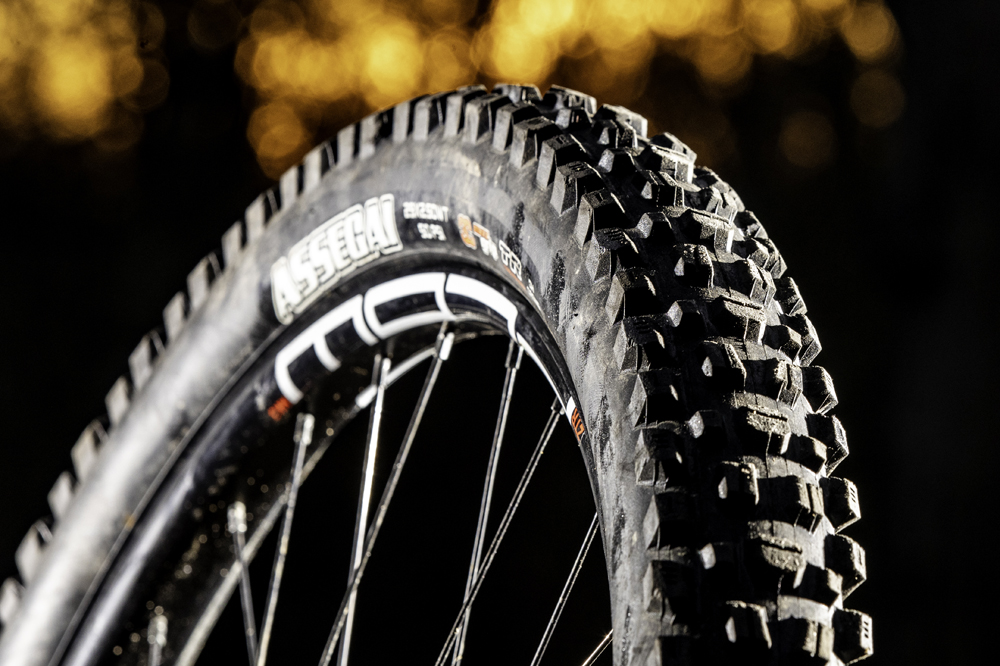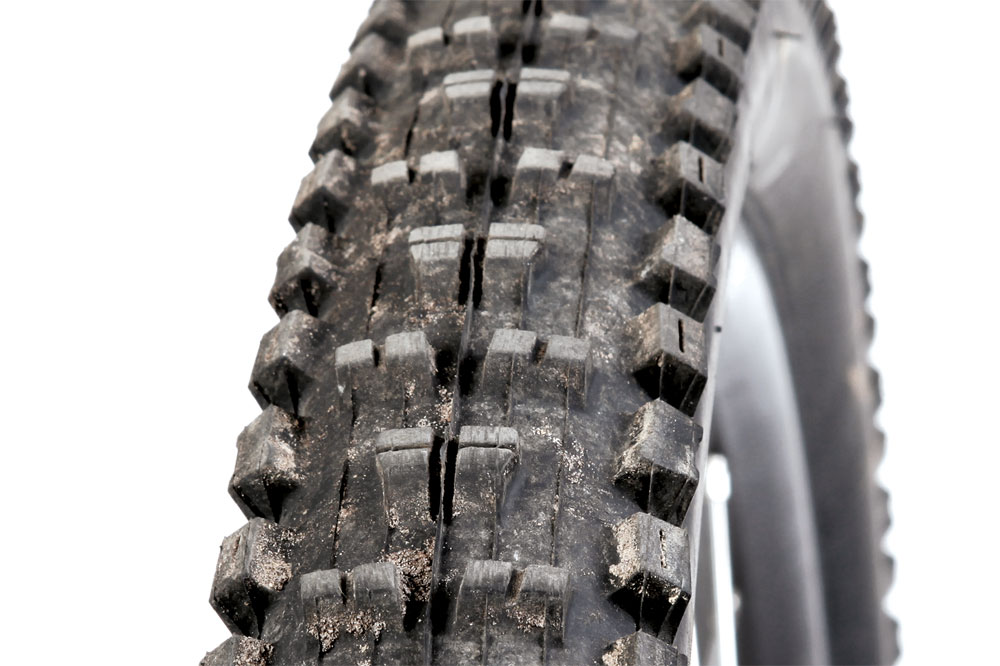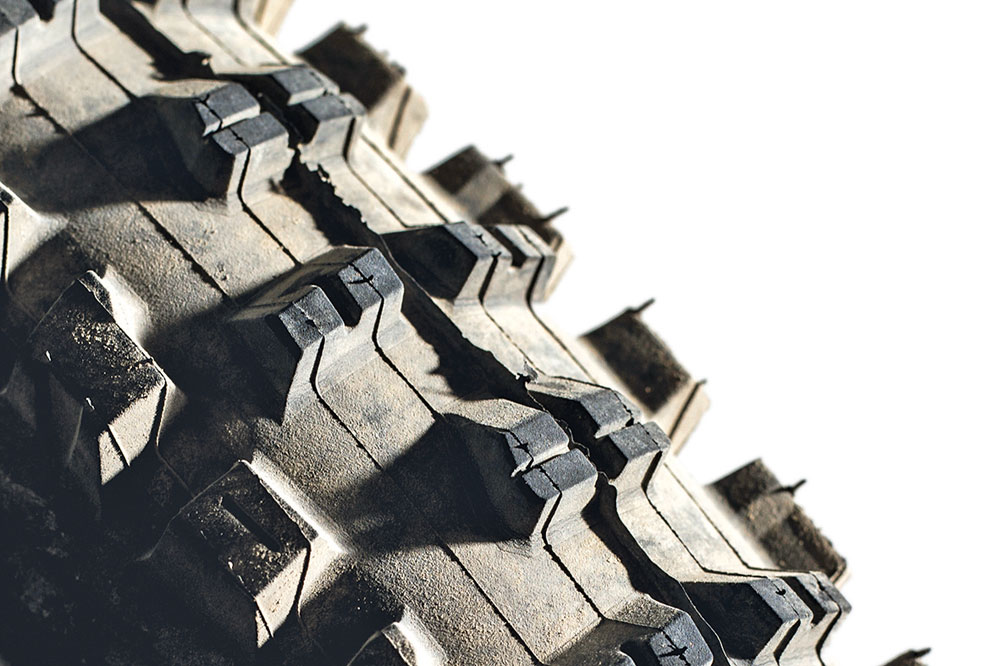Products You May Like
Ultimate grip? Fastest rolling speed? Ride in sand? Rocks? Or loam? Here are the eight best mountain bike tyres for you and your trails.
Choosing the very best mountain bike tyres is a minefield. A minefield of widths, tread patterns, carcass constructions and rubber compounds. But we’ve sifted through the numerous models on the market to come up with the definitive list of recommended rubber. We’ve concentrated on trail and enduro tyres, since they cover the most popular forms of riding and help you exploit the capability of a modern mountain bike on modern trails.

Maxxis Minion DHR II
Best rear tyre for mixed conditions but also good up front
Weight: 1,010g | Size tested: 29 x 2.4in | Actual size: 60.4mm | Rating: 10/10
Pros: Excellent grip without excess drag. It works really well on the front too!
Cons: Multiple versions can be confusing (get 3C MaxxTerra for rear tyre). Slightly undersized compared to other beefier brands
With its blocky tread slabs and pronounced shoulder channel, the Minion is a mountain bike classic and regular winner of our group test. The new EXO casing model should help prevent the kind of small cuts and nicks we’ve suffered in EXO tyres in rocky areas (often at the tread or tyre crown SilkShield now extends to) and the technology adds less than 100g, dependant on tyre size. The DHR II already delivered class-leading grip and a super-planted cornering sensation. This new EXO+ model doesn’t feel any less comfortable or secure, making it a really good compromise for a minimal weight penalty. This reinforced model isn’t a full-on Alpine-ready tyre, but will likely become the new go-to UK choice for many, especially if you’re riding takes in anything sharper than pure dirt and loam where you’ll benefit from the extra protection.
Read our full test review of Maxxis Minion DHR II tyre

Maxxis Minion DHF
One of the best mountain bike tyres of all time
Weight: 840g | Size tested: 29 x 2.5in | Actual size: 62.6mm | Rating: 10/10
Pros: The tyre that started it all. Loads of versions – so you can find the one best suited.
Cons: Loads of versions – can be confusing to choose best one. You have no excuses with this tyre!
With a 3C Maxx Terra Minion DHF slapped on the front wheel, continuous predictable grip is almost never ending right up to properly wet conditions. Maxxis’ sticky rubber feels trustworthy to lean, even on rocks and roots, but its wear life and durability isn’t class leading. The tyres do scrub off out at a steady, uniform rate though, rather than falling to pieces. The classic ‘L’ shaped lugs and long rectangular, ramped centre knobs remain, but the tread pattern is pumped up to suit the bigger casing. The Minion has always been a fast favourite in loose and dry terrain, but in the wet, doesn’t quite bite as hard as more splayed out treads in softer dirt. With increased air volume, the 2.5 can be run a few psi lower, upping comfort and conformity, and laying down more rubber, so grip levels have really ramped up.
Read our full test review of Maxxis Minion DHF tyre

Schwalbe Magic Mary
Best front tyre for mixed conditions
Weight: 928g | Size tested: 29 x 2.35in | Actual size: 60mm | Rating: 9/10
Pros: Pure traction and predictability. Lasts longer than most softer compound tyre.
Cons: Loads of versions – look for Orange stripe. Slightly undersized, so size up if you want big volume.
The 2.35in Magic Mary blows up bang on size, with a very aggressive tread rocking pumped-up, reinforced edge blocks. The new 2.6in versions we’ve also tried are more spaced out and look like a tractor tyre. These are a bit of a grip monster, especially in winter in the Ultra Soft Purple version, but the very open tread blocks bobble more and are less assured and drifty on hardpack. The new Addix compound feels confident in the steeps on wet or dry rocks and roots, even if some testers reckoned there’s a slight sense it’s a tad springier and less glued to the ground than the older Trailstar rubber. It’s a bit of a toss up with the Maxxis Minions and High Rollers for the crown of best aggressive, mixed conditions performer. There’s a strong argument for either brand, so it ultimately comes down to personal preference.
Read our full test review of the Schwalbe Magic Mary tyre

Continental Kryptotal tyre
Conti back at its best
Weight: 1,080g | Size tested: 29 x 2.4in | Actual size: N/A | Rating: 9/10
Pros: Grip is superb. Stiff casing lets you run lower pressures. Decent rolling speed.
Cons: Not available in a lighter casing – yet.
This Kryptotal is the main do-it-all, mixed conditions tyre, and the only one of Continental’s new range of tyres that comes in end-specific models. The rear here has fat ramped central lugs and is optimised for better braking, and a front option with squarer central knobs should have a more sure-footed feel that lays down slightly more rubber. If you want the oddly-named Kryptotal in the stickiest rubber, you’ll currently need to go with the full DH casing, so enduro riders craving maximum grip, but not max weight on the front will have to wait a while longer for the perfect version. There’s a calm and planted ride where the tyre traces and dulls edges really well and rubs out small vibrations and chatter way better than previous Contis. Considering the damped feel and serious tread, rolling speed is fine too.
Read our full test review of Continental Kryptotal Enduro R Soft tyre

Specialized Eliminator tyre
Impressive performance for a bargain price
Weight: 955g | Size tested: 29 x 2.3in | Sizes: 27.5/29in x 2.3/2.6in | Actual size: N/A | Rating: 9/10
Pros: Excellent value. Fast rolling. Works great as a rear tyre.
Cons: Not the best braking traction or cornering grip.
This Specialized Eliminator is literally half the price of some other brands top-level models. Yes, it does cost more money in the tougher, dual ply Gravity casings or squidgier T9 rubber blend, but Spesh’s excellent price never exceeds £50 in any version. That wouldn’t mean much unless it delivered, but this has a great inflated shape, much tougher and more supportive casing than previously and a sensible tread pattern that is excellent on the back end. The Eliminator works well as a front or rear trail tyre but for e-bikes and enduro bikes we’d restrict it to rear use and look at running the more aggressive Butcher up front. Overall, the Eliminator reminds us a lot of a Maxxis Dissector, but with less of a severe on/off feel to the cornering grip when leant over, which will arguably suit more riders.
Read our full test review of Specialized Eliminator Grid T7 tyre

WTB Verdict
Best front tyre for mud
Weight: 1,280g | Size tested: 29 x 2.5in | Actual size: N/A | Rating: 9/10
Pros: Great in anything not-firm, whether mud or dust. Much more versatile than an all-out mud spike.
Cons: A bit on the hefty side. Super slick roots and rocks require softer compound.
As a dry tyre the WTB Verdict is usable, if far from optimal, with slight understeer compounded by hefty weight and slow rolling. But as summer turns to winter, the WTB Verdict really comes into its own. Yes, it is draggy, but nothing feels fast on flat transitions when it’s this muddy, and when you do get to a descent, the grip it generates is pure black magic. Downsides? Well, aside from the aforementioned extra weight and drag, the rubber seems to ping off roots and rocks and can get quite lively if there’s no dirt to sink its teeth into. Certainly it feels like the blocks have a faster rebound than Maxxis 3C Maxx Terra. Other than that, we can safely say the Verdict is even happier than a pig in sh*t.
Read our full test review of WTB Verdict tyre

Maxxis Assegai
Best front tyre for dry
Weight: 1,330g | Size tested: 29 x 2.5in | Actual size: N/A | Rating: 10/10
Pros: The new Minion DHF? Particularly good at hard cornering.
Cons: Hefty. Can be draggy if you get a softer compound version.
The Assegai is, if push comes to shove, our current favourite front tyre, specifically in 3C Maxx Terra, EXO+ version tested here that uses a reinforced, single-ply, construction, and slightly harder rubber compound. The Assegai fills in some blanks on its grip channel with extra toothy knobs, so there’s less dead space than most Maxxis patterns. Everywhere non-muddy – whether loose soil or hardpack, dust or grease – traction is class-leading. Jutting out at sharp angles, the tall edge blocks are very aggressive, and heavily siped like the central tread. They dig in and don’t let go, and there’s an extremely consistent feel all the way onto the side knobs, which means grip is really easy to judge, to the extent we’re struggling to think of a single occasion in hundreds of rides where the tyre has let us down unexpectedly.
Read our full test review of Maxxis Assegai tyre

Schwalbe Hans Dampf II
Best rear tyre for dry
Weight: 920g | Size tested: 27.5 x 2.6in | Actual size: 65.5mm | Rating: 9/10
Pros: Fast roller but not sketchy any more. Pairs brilliantly with Schwalbe Magic Mary up front.
Cons: Can be hard to find your Goldilocks casing. Can break out when things get dusty dry.
One big benefit of Schwalbe’s latest Addix rubber formulas is rapid rolling speed and an energetic, zingy, sensation, so you don’t ever feel like you’re dragging your bike around all day with the brakes on. Addix blends are now so durable, in fact, that they last longer than most other rival equivalents. Another bonus of the new edge blocks being chunkier, and donning outer reinforcing struts – like the Magic Mary – is being much better at resisting squirm and folding. So the Hans feels more stable under load at high lean angles. This means it’s no longer prone to sudden grip loss with small edge blocks buckling, but still doesn’t quite pack the punch of flatter-topped tyres when cutting into loose turns or holding wet cambers. And with a very rounded profile, it displays a more consistent grip, than transitioning from slip to grip.
Read our full test review of Schwalbe Hans Dampf II tyre

Kenda Hellkat
Best value all-rounder
Weight: 851g | Size tested: 27.5 x 2.4in | Actual size: 61mm | Rating: 9/10
Pros: Excellent predictable capability everywhere. Impressively light without being flimsy.
Cons: No complaints at this price!
The widely spaced, blocky tread has softer durometer shoulders and a firmer rolling strip, although both zones still feel pretty squidgy to touch. The tread is more of an open, motocross-style affair with pretty aggressive edge knobs and a mostly uninterrupted shoulder channel. On fast or technical tracks, the slow-rebounding Hellkat is comfortable, damped and glued to the ground, making it feel seriously assured. It never does anything strange or upsetting, and this trail version appears to share similar massive grip levels with the softer, tougher DH version that would work well as a Lakes or Scotland bomber. In corners and off-camber, the soft knobs have enough base stiffness to bite without flexing or chattering and feel more continuously ‘locked on’ than ‘drift-then-catch’. Overall traction turning and braking is huge on all surfaces, wet or dry.
Read our full test review of Kenda Hellkat tyre
How we tested the best mountain bike tyres:
For back-to-back testing, all tyres were set up tubeless on modern, wider rims and hammered hard at various spots, both in the UK and abroad. The same bike was used for comparison laps on the same hill, giving direct final analysis between brands. Air pressures were set dependant on casing thickness and suppleness for optimum ride feel for each brand and tyre – mostly around 28psi rear, and 25psi front. Thanks to recent hot spell of weather, we were in the unusual position of not riding one of the newest tyres in the wet, but rain on the before our test completion meant we were able to carry out some 11th hour wet weather testing too.
What do I need to look for in the best mountain bike tyres?
Tyres are a vital piece of kit that connect your bike to the trails. They control everything from cornering grip to braking traction, and rolling speed to cushioning and comfort. These multiple factors can totally transform your ride experience, and can actively keep you safer on a variety of trails and help prevent crashes..
Modern tyres are continually improving, so compound blends, tread patterns, and construction technologies are better than ever, allowing harder riding with less downtime. In fact, if you set up the right tyre tubeless, and you’re prepared to compromise a little on weight, it can deliver huge levels of grip and virtually eliminate cuts or punctures.

Sidewall information centre
How much difference does the rubber compound make?
Rubber hardness is measured by a durometer on the shore scale. Higher numbers signify firmer compounds: 60a is harder and longer lasting than 50a rubber. The secret ingredients and rubber chemistry tyre brands use are something of a mystery and can also make a huge difference to grip, rebound damping and rolling speed. So the answer is that rubber compounds make a significant difference, and you need to decide whether you are prioritising ultimate grip (in wet or dry) or low rolling resistance, along with other factors such as weight, casing stiffness and width.

Tread knobblies
What do differences in tyre tread pattern make to performance?
Widely-spaced treads bite better in looser surfaces and clear mud more effectively, but can also increase rolling resistance. Sipes and cuts help braking and the way the tyre deforms to obstacles. A more pronounced channel between shoulder and centre knobs can deliver better off-camber bite and a sensation of ‘railing’ turns, but some riders prefer a more continuous, rounded feel than the on/off grip generated by such a tread gap.

Sizing info
What air pressure should I run in my tyres?
Different tyres require specific air pressures. A rough rule of thumb is: the thicker the casing, the lower the air pressure you can get away with. Equally, the bigger the tyre volume, the lower the pressure you can run, and vice versa. For maximum comfort and grip, aim for the minimum pressure that keeps the casing from twisting too much and still prevents rim strikes under impacts. Experiment with lower pressures if you often run over 30psi.
What about casing construction?
Casing thickness and precise ply lay-up has a big impact on ride quality and affects conformity, rolling speed and durability. Harder charging riders might have to accept the extra weight of meatier casings to prevent punctures and stop sidewalls folding under cornering forces. Heavier tyres accelerate more slower, but feel more planted and stable once momentum takes hold. Tubeless is always the way to go – inner tubes feel dead and lifeless, and cause more issues in our experience.
Should I choose a wider or narrower width tyre?
Using wider tyres up front for extra grip and comfort makes good sense. Arms get more cushioning and comfort, and, like skis, narrower rears can help initiate faster turning. Tyre width is directly relative to air volume, and larger volumes provide more isolation, damping and control, up to a point. Wider tyres add weight for climbing and acceleration, but rolling speed between different widths should be so close off-road, it’s not such an issue.
What kind of weight are modern MTB trail tyres?
Wider, more aggressive tyres need lots of support to keep tread blocks stable and use more casing material and rubber, which all adds weight. Bigger, heavier tyres can stabilise the bike by being harder to deflect at speed and larger air volumes offer more isolation from the ground too – especially useful to smooth out rougher terrain on shorter travel rigs. Now, anything under 1,000g is considered relatively light, while over 1,200g is heavy for enduro/trail use.

Ramped knobs aid rolling resistance
Are front specific mountain bike tyres worth considering?
Using wider tyres up front for extra grip and comfort makes a lot of sense. Hands get extra cushioning, and slightly narrower rear tyres can also help initiate faster turning. Tyre width is directly relative to air volume, though, and a larger air volume provides more isolation, damping and control.

Speedy rear
Are rear specific mountain bike tyres worth considering?
With a faster rolling, lower profile centre strip and pronounced edge blocks for leant-over grip, semi-slick tyres can be a great UK option. This is why we’ve largely resigned full-on XC tyres to history for trail riding. The extra bonus of the slip-to-grip attitude of semi slicks makes them a real hoot in greasier conditions.
